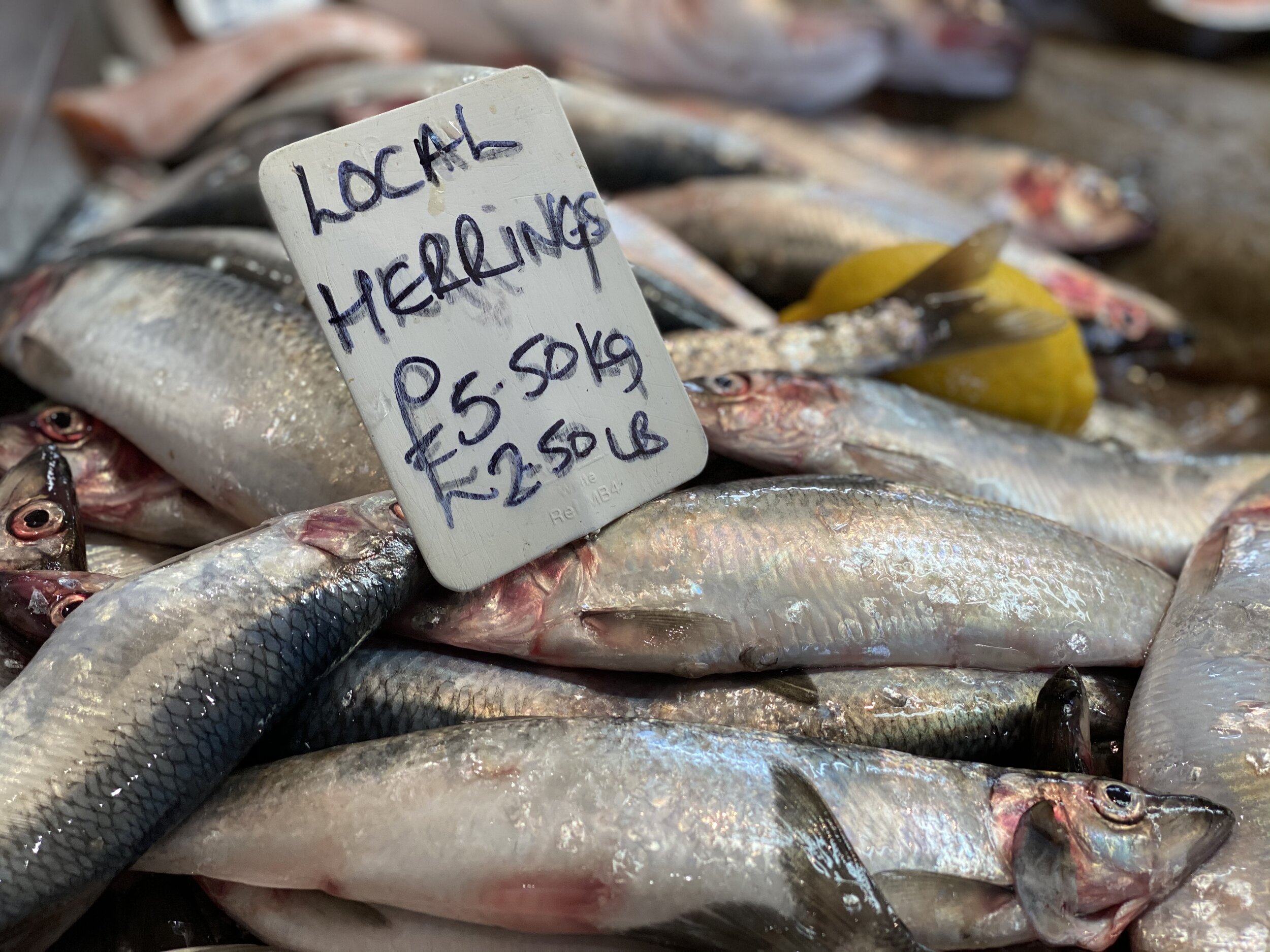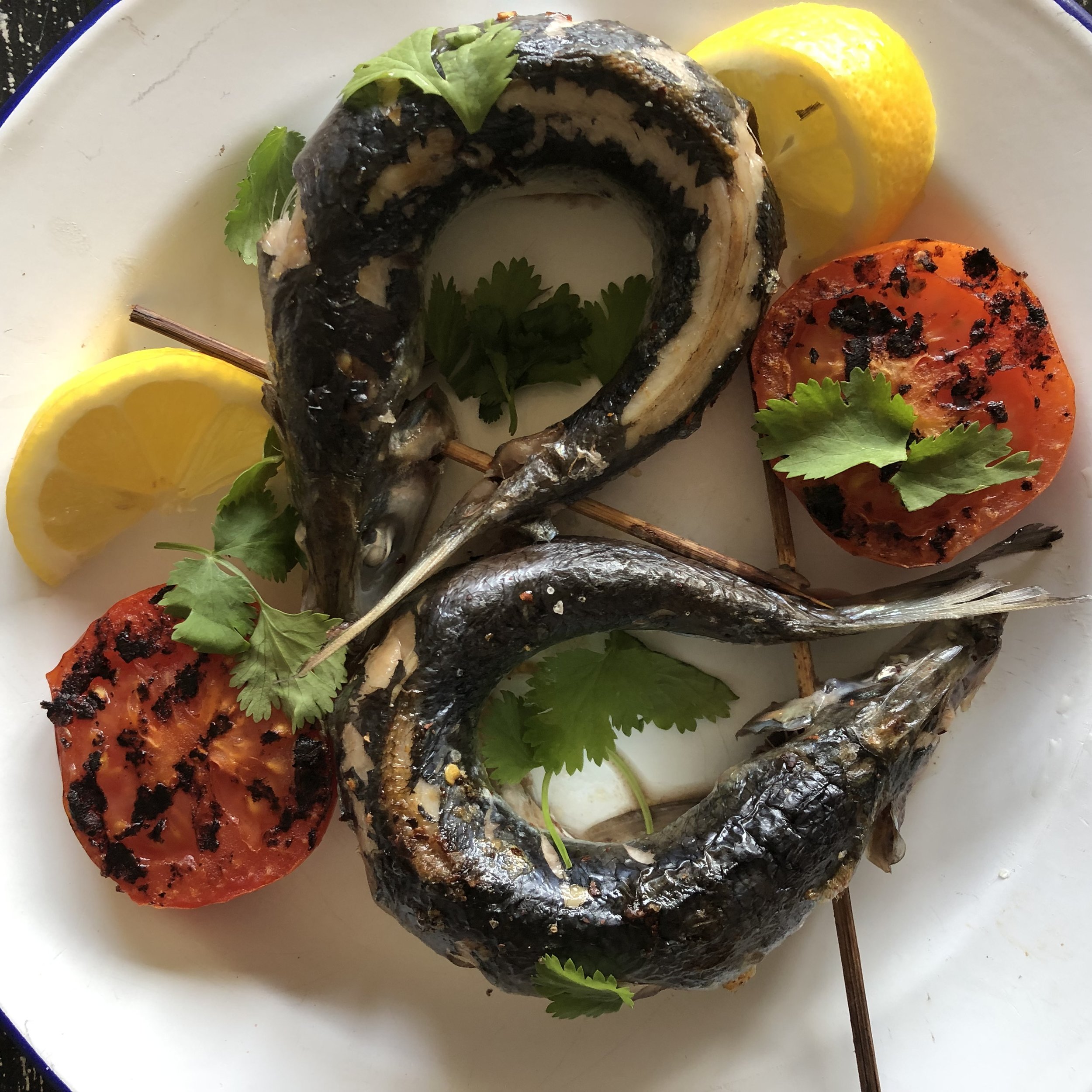The Hastings Herring Fair
As part of my role as a Seafish Ambassador, I make a point of visiting seafood festivals and food events around the UK where (a) there is great story to be told and (b) I’m going to reach a receptive and enthusiastic audience. Following my seasonal quest to discover the reasons why we eat so little herring any more, I was delighted to be asked by my great friend and fellow seafood aficionado, CJ Jackson, to jointly host a series of herring cookery demos, at the annual Hastings Herring Fair, in the aptly-titled ‘Classroom on the Coast.’
Now CJ has a phenomenal knowledge of seafood and is a brilliant cook and so with our combined passion for storytelling and showcasing seasonal seafood, it was always going to be a great event, but it exceeded even my expectations and we enjoyed 4 packed shows where we waxed lyrical about the ‘Silver Darlings’ and cooked and enthused over 8 different herring dishes over the course of the weekend.
Hastings itself boasts the UK’s largest beach-launched inshore fishing fleet and comprises an multitude of wooden and GRP vessels of all shapes and configurations. The fishermen here are some of the most engaged and passionate that I’ve met and fiercely defend their craft via the Hastings Fishermens’ Protection Society. Its economic importance stretches way further than the high water mark too, with a staggering worth to the local economy of £8m/year, before even putting to sea, such is its influence with the local tourist trade.
The fishery here is artisanal, low-impact, seasonal and definitely sustainable with a mixed fishery that provides stunning mix of quality species of both fish and shellfish throughout the year. Naturally we were there for the herring, recently descended on the fishery in their glistening multitude. So, with aprons on and knives at the ready we challenged visitors not to be utterly captivated and enticed by this delicious and nutritious little fish that men used to call the ‘King of the Sea’
Although the weather was a little damp, spirits certainly weren’t and with an array of fresh and smoked herring from Rockanore Fisheries, we set about putting the record straight with this wild superfood in terms of nutrition, flavour, affordability and seasonality. Smoked herring - kippers and bloaters (cold smoked) and buckling (hot smoked) are the most popular traditional forms, with the latter two being smoked with the roe and gut in. Hot smoking renders the fish ready to eat, but cold smoking requires cooking either grilling, jugging (poaching), baking or frying.
As for the fresh herring, ably scaled and gutted by our Commis, Serge, from Westgate College, I decided to prepare my old favourite, baking them with lemon and tomato in a very traditional style, with the fish pinned tail to head with a cocktail stick. I then poached some and made my potted herring recipe and then having been inspired by a Nathan Outlaw mackerel recipe, produced a raw herring tartare with spring onions, lemon and parsley, (which was probably my favourite) - the older I get the more I just love raw seafood…..
CJ, on the other hand, not content with the smoky offerings from nearby Rockanore, decide to demonstrate the art herself, turning out the most beautifully russet-coloured, buckling in just a few minutes, with her stove-top smoker. She then followed this with herrings in oatmeal with crispy bacon (an awesome combination) and fried with salsa verde, which always seems to go down well.
And then there were the roes….oh those roes! Lightly fried in a beurre noisette, both hard and soft and laid temptingly on slices of wholemeal toast, soaking up the seasoned buttery foam.
Our attentive audiences over the 4+ hours of displays, were thoughtful, engaged and enquiring and to be honest we couldn’t have asked for more. Certainly the dishes proved incredibly popular with something akin to a biblical plague descending on the tasting table after each session.
Interspersed with the cooking, I did my best to recount herring tales of yore and shed some light on the huge impact this little shoaling, silver fish has had on our coastal communities from Peterhead to Lowestoft and from Hastings to Clovelly. Storytelling is becoming a large part of what I do and it’s so incredibly gratifying when, after the demo, eager, questioning hands are raised and the ensuing compliments always bring a huge smile.
So a great success and bravo Hastings. I’d not been before, but I’ll certainly return and to the ‘classroom on the coast’, for another and this time, betentacled, seasonal offering…..
Silver Darlings - A Potted History of the Herring
A Short History Lesson!
The British herring fishery pre-dates the capture of many other species and in 1295 Edward I decreed that the Dutch should be allowed to fish from Yarmouth for herring ‘unmolested’ – (not much change there then!!) and of course competition ensued and struggles for the control of the herring fisheries were inevitable, giving rise ultimately to the emergence of the Royal Navy as protector of the shoals.
By the mid 17th century, the herring industry was booming and in 1650 the Navigation Act demanded that only British-caught fresh herrings were to be imported to our shores and by 1666 all trade in foreign herring, salted, dried or bloated was prohibited too.
Fishing for herrings was actively encouraged by parliament through the 1800’s and by the early 1900’s a vast industry was encompassing the Isles from Shetland to Cornwall, the Firth of Forth being noted for its abundance. An army of fisher-girls descended on ports and towns to clean and salt the fish down into barrels, from the Orkneys to Lowestoft, following the shoals throughout the seasons, as they migrated South toward the Channel.
Just before the First World War did the fishery peak, with a estimated 1500 herring ‘drifters’ crewed by 15,000 fishermen, landing 12,000,000 cwt of catch. The ensuing turmoil of war then depleted those landings by over half, fishing communities subsequently came under much economic pressure and in 1935 The Herring Industry Board was set up to monitor and manage the markets.
Following the Second World War the demand for protein increased, the fleets reinvested and improvements in fishing techniques and technology increased catches further. By the 1950’s overfishing of herring was a serious problem and landings fell dramatically and steadily right up to 1977, when the lowest catch for a century was recorded, with a spawning biomass (volume of adult herring) of only 150,000 tons and a 4-year ban on their harvesting was the inevitable result.
Of course with the stocks under pressure and ban enforced, a whole generation suddenly missed out on eating this wonderful fish and its popularity waned further. With dietary concerns never more important than today and rising obesity levels driving the health and superfood trends, this consistently overlooked resource could go a long way to redressing the balance in a thoroughly delicious and digestible form.
So where to find yourself some fresh herring? It’s a tricky one, as fishmongers have likewise responded to demand and they’re not a common sight on slabs anymore. But that’s where you need to start and ask - put in a request and see if they can source them for you, then get them to gut, scale and even fillet for you, so your first experience is a good one. Try frying the fillets lightly in seasoned flour and butter or grilling or griddling, brushed with a little light oil. Use the roes, (eggs) hard for making taramasalata or the soft male ‘milts’ fried in butter on some fresh toast.
If you can’t get fresh, then try them smoked as kippers or bloaters or pickled, as rollmops, which are so easy to eat because the tiny bones are broken down to nothing in the cure and make a wonderful go-to snack. Whichever way you choose though, be open-minded and remember that what you’re eating is wild, first class protein in its truest form.
Enjoy!
Baked New Season Herring with Lemon and Tomatoes
If there’s one fish which symbolises the downfall of the British consumer’s seafood eating culture, it’s the herring. Most definitely. An affordable protein staple for centuries, whole communities were founded on its capture, processing and sale. The very coastline and infrastructure that we enjoy today has in places been heavily influenced by this ‘King of the Sea’ from the Shetlands to Lands End. Indeed, so abundant were the glistening, dense shoals that migrated on their seasonal journey southwards to spawn, that a colossal industry was born and the rights to the landings protected fiercely.
The British herring industry reached its nadir in the early 1900’s with the Herring Industry Board regulation production and volume across the UK (https://eastcoastavocet.com/2018/03/31/the-fish-that-made-history) with over 12000 fishermen actively engaged in its harvest. Legions of Scottish fisher girls would follow the fleets as they steamed after the ever-moving fish; gutting, cleaning and packing.
The herring was an institution. Whether smoked, baked, pickled, salted or dried, the nutrition afforded by this iconic species, allowed everyday folk to eat wildly and well. Over time however, technology improved, efficiency doubled and by the end of the Second World War catches were going into decline. Overfishing eventually took its toll and by the late 1970’s a total ban on landing herring was introduced in the North Sea to allow stocks to recover. However, a whole generation would miss out on the opportunity to enjoy herring, as silently they disappeared from fishmongers’ slabs across the UK.
So to celebrate this incredible nutritious ‘superfish’, here’s a recipe to tempt your taste buds, using a gem of a cook book that was bought for me and that describes just how important this fish was to the national diet back in the pre-war 1930’s.
I was given this book, (well, more of a pamphlet) - The New Herring Book, published in 1938, which is full of ‘scores of nutritious herring recipes.’ Here’s just one, which really brings out the flavour and uses the whole fish in a lovely hour of easy to prepare, seafood theatre.
Baked Herring with Lemon and Tomatoes
Serves 2
Ingredients
4 whole new season herrings, (gutted and cleaned)
2 lemons, cut into wedges
4 large tomatoes (halved)
2 tsps butter
Sea salt
Black pepper
4 cocktail sticks
Method
Take the herrings and if necessary, clean further by washing in cold water and removing any remaining scales with a scaler or the back of a kitchen knife.
Score the flanks of the herring each side and spread a little butter in the body cavities. Squeeze a little lemon over the fish and season well with salt and pepper. Skewer the heads and tails of the herring together using the cocktail sticks and place in a foil lined baking dish with enough foil to create a parcel.
Tip
If using whole fresh herrings that you need to gut, keep the roes back, then dry them and add a squeeze of lemon juice and little ground nutmeg. Replace in the body cavity to bake - delicious!
Now season the tomatoes and place around the herring with the remainder of the lemon wedges. Cover with the sides of the foil to create the parcel and bake under a moderate heat - 180C Gas 4 for 15 mins.
Take out the herrings and open up the parcel and bake for another five minutes.
Remove from the oven and serve immediately with the tomatoes, lemons and some wholemeal or granary bread.
A very fine dish indeed and so incredibly healthy for mind body and soul……
















